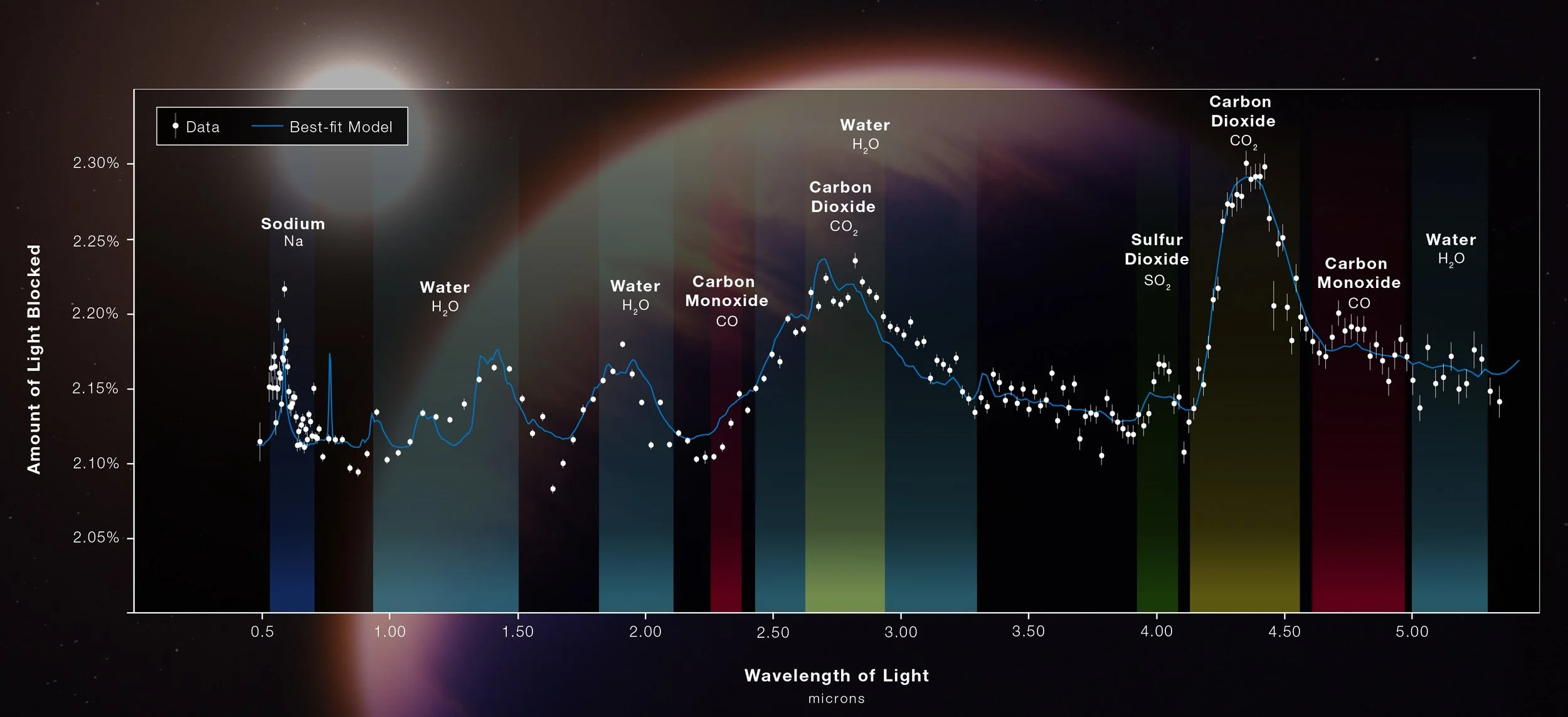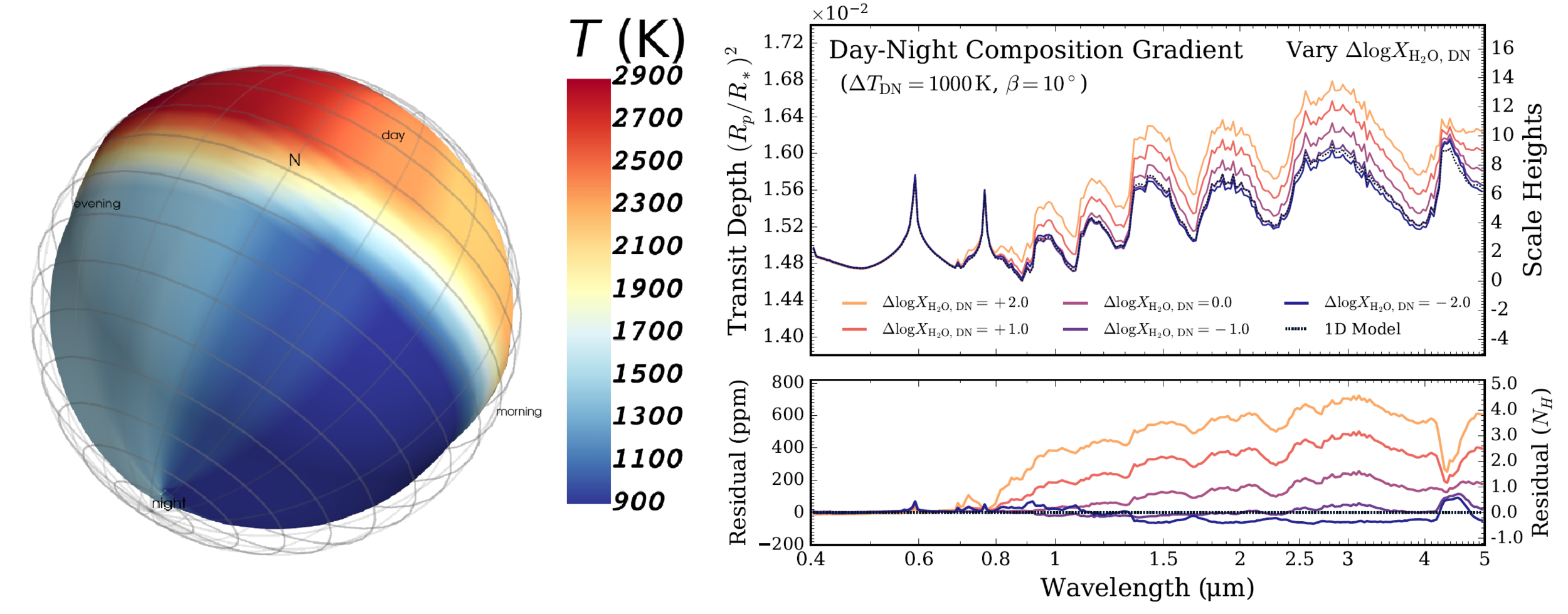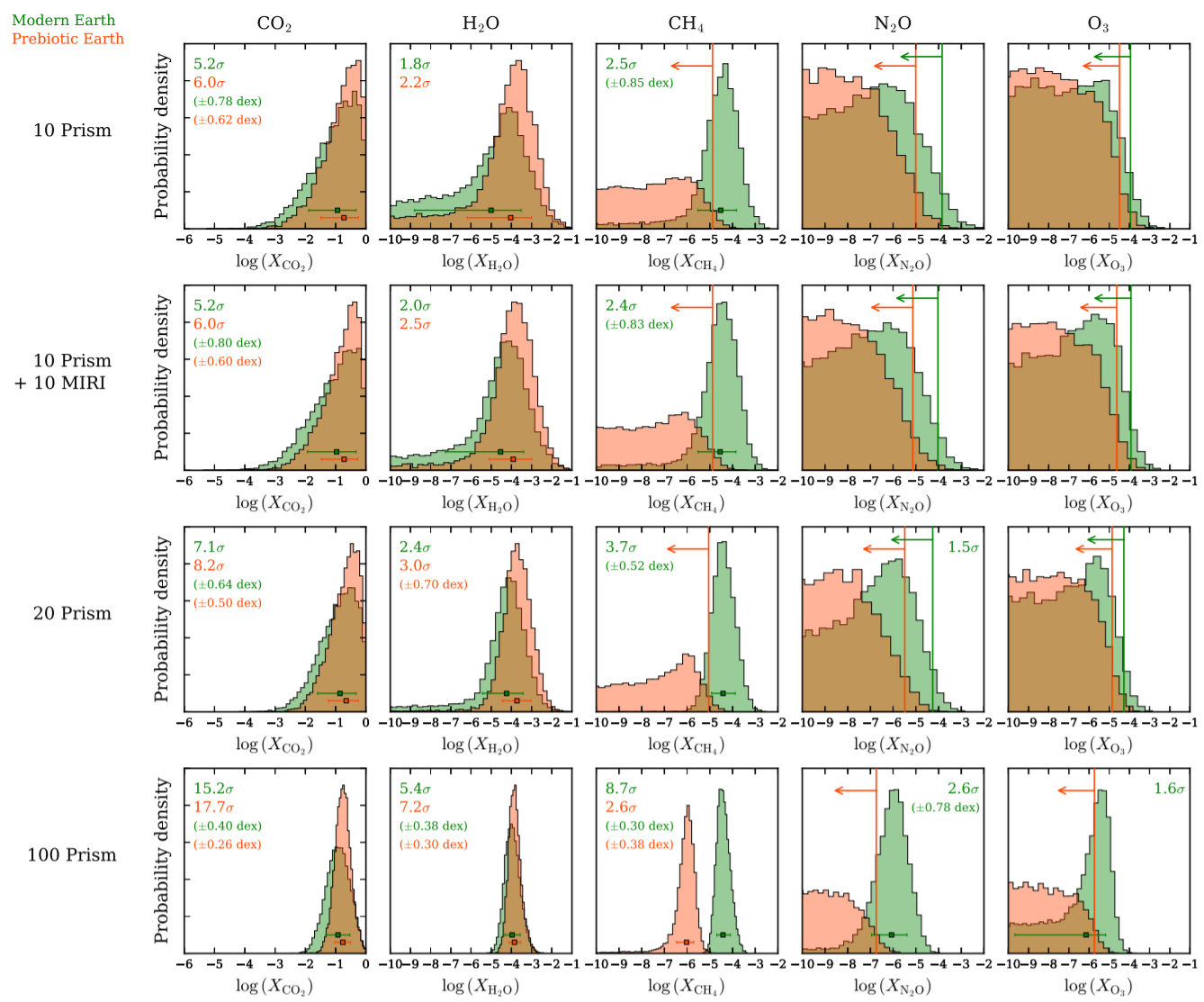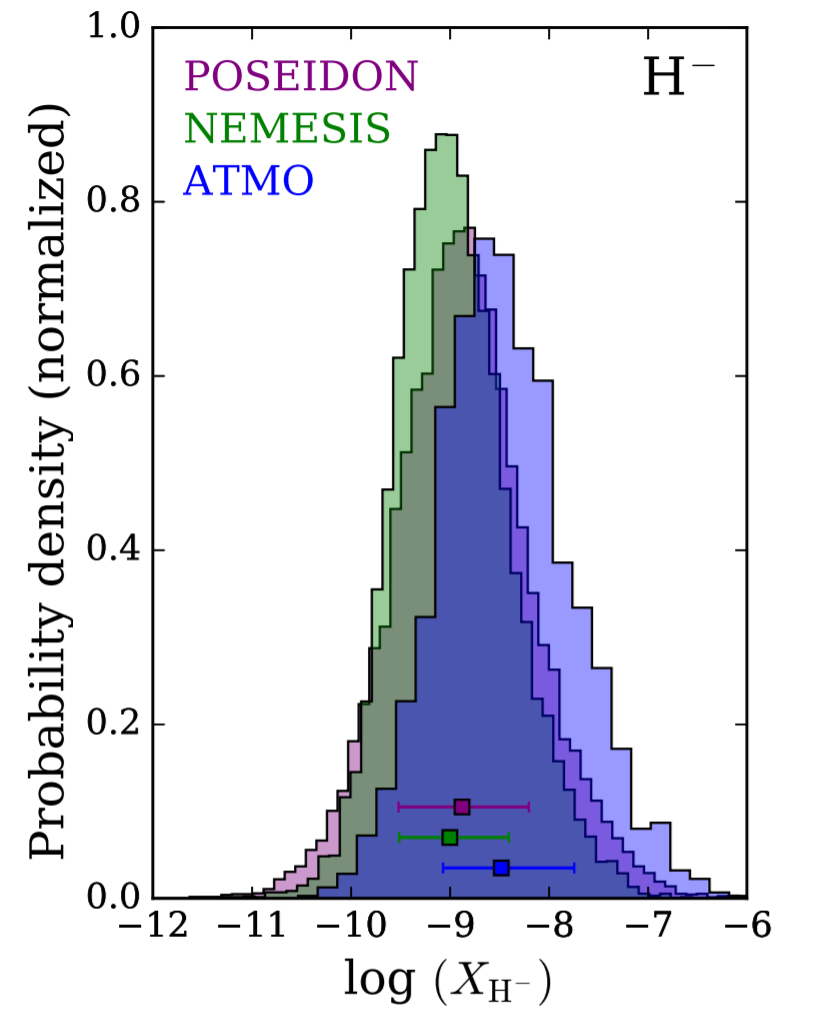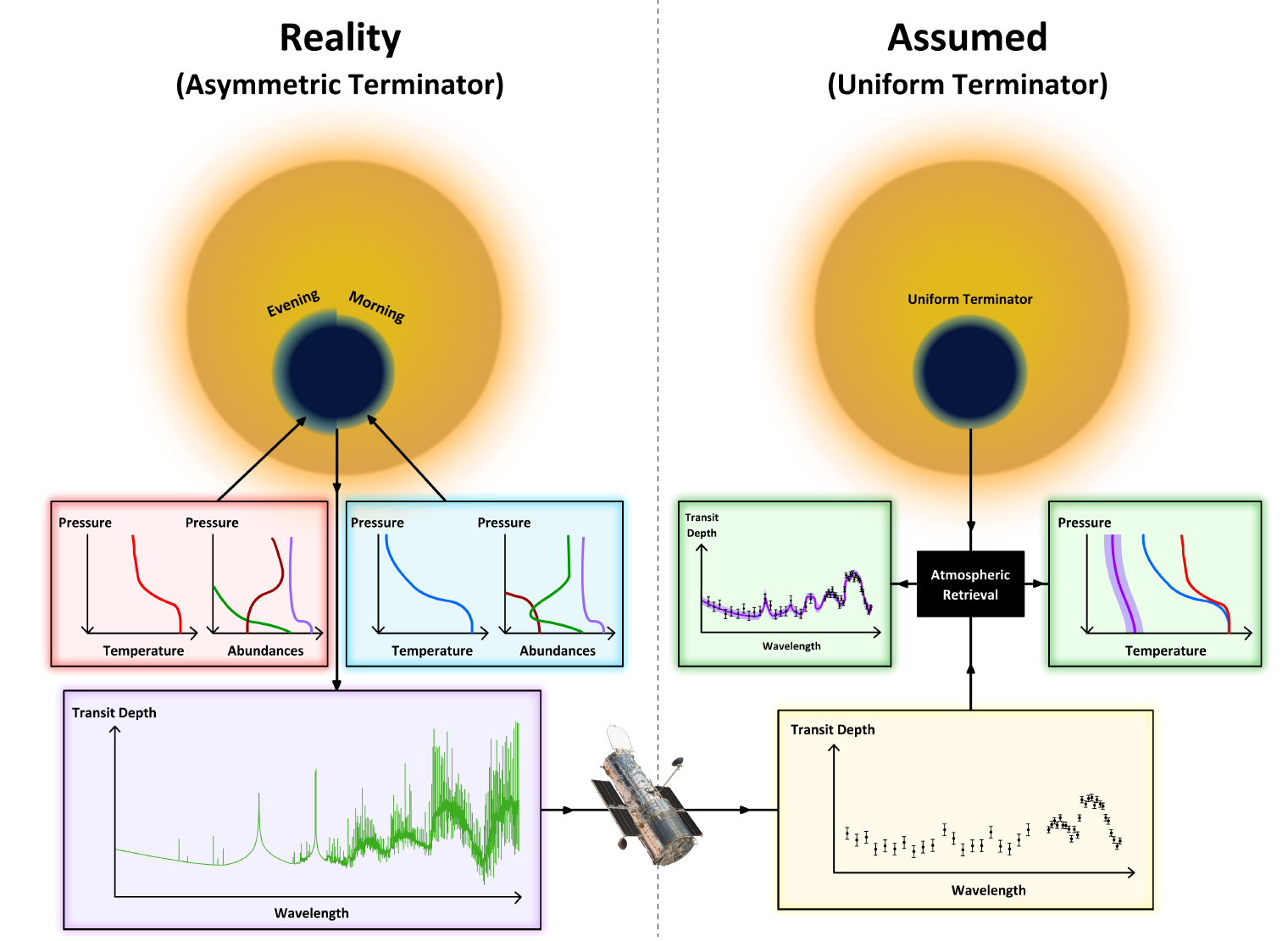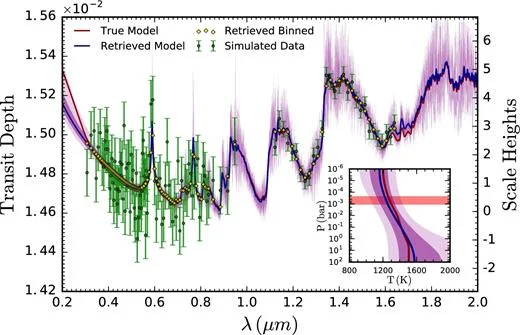Research Highlights
My research principally revolves around the development and application of atmospheric retrieval techniques for transiting exoplanets. Areas of interest include: exoplanet characterisation ranging from gaseous giants to rocky worlds, radiative transfer, atmospheric physics and chemistry, and techniques to identify and study biosignatures with future telescopes.
2024
JWST Spectra of a Habitable zone ice world exoplanet
Perhaps the most high-profile goal of exoplanet science is to detect atmospheres on exoplanets in the habitable zone and search for life. In pursuit of this goal, we observed a transmission spectrum of the habitable zone super-Earth LHS 1140 b, a planet 70% larger than Earth, with JWST to search for an atmosphere. LHS 1140 b’s high gravity and relatively low stellar insolation makes it highly likely to retain a thick atmosphere.
Our observations found tantalising evidence of a nitrogen-rich atmosphere on LHS 1140 b (which will need to be confirmed with additional observations). A nitrogen-rich atmosphere would allow LHS 1140 b to support habitable liquid water conditions on the centre of its dayside, giving the planet a distinctive ‘eye ball’ appearance (as shown in the artist concept above).
2023
First Rocky exoplanet spectra with JWST
I am part of a team conducting a survey of rocky exoplanets orbiting M-dwarf stars with JWST. Our team is searching for evidence of atmospheres around these rocky exoplanets as a pathfinder towards understanding the habitability of planets around the most common type of stars in our galaxy.
We published transmission spectra for three rocky exoplanets in 2023:
LHS 475b: the first rocky exoplanet confirmed by JWST.
GJ 486b: the first non-flat transmission spectrum of a rocky exoplanet, indicating either an atmosphere rich in water vapour or contamination from starspots (featured above).
GJ 1132b: potential evidence of a water-rich atmosphere containing methane, but an inconclusive second transit requires future observations to confirm.
2022
First exoplanet science with JWST
I am part of the international JWST Transiting Exoplanet Community Early Release Science Program (ERS). We observed the hot Jupiter exoplanet WASP-39b with JWST, the world’s newest flagship space telescope, to verify its exoplanet science capabilities. We reported a series of remarkable discoveries, including the first detections of carbon dioxide (CO2) and sulphur dioxide (SO2) in an exoplanet atmosphere.
I also produced a video on behalf of the ERS team highlighting our first JWST results:
a rapid 3d model for exoplanet transmission spectra
Most exoplanets discovered to date are tidally locked, with a permanent dayside and nightside, due to their close-in orbits. Tidally locked exoplanets have extremely non-uniform temperatures and compositions throughout their atmosphere, necessitating a 3D treatment to compute their spectra. We have developed a new model, TRIDENT, which uses freshly developed algorithms to rapidly compute 3D transmission spectra of exoplanet atmospheres. TRIDENT will play a key role in analysing observations of hot Jupiters from the James Webb Space Telescope.
2021
Biosignature detectability for trappist-1e with jwst
The Earth-like planet TRAPPIST-1e will be one of the first rocky planets in the habitable zone to be observed with the James Webb Space Telescope. We investigated how much observation time with JWST would allow one to distinguish between atmospheres resembling the modern Earth or prebiotic Earth. We find that 20 transits can constrain CH4, but over 100 transits would be needed to infer other biosignatures like O3 and N2O.
Evidence of h- in hot Jupiter atmospheres
The ion H- is a sensitive probe of atmospheric chemistry in hot giant exoplanets. Using Hubble Space Telescope observations, we reported evidence of H- in the atmospheres of two hot Jupiters: HAT-P-41b and WASP-79b. The presence of H- was independently inferred through a comparative analysis with three separate atmospheric retrieval codes for both planets. The measured abundance of H- is around 6 orders of magnitude higher than expected from chemical equilibrium predictions, suggesting that UV-driven photochemistry drives H- production in hot Jupiters.
2020
The white dwarf opportunity
The search for life beyond the solar system will become possible with the launch of the James Webb Space Telescope in 2021. But finding biosignatures may be challenging for currently-known exoplanets. We show that rocky planets in the habitable zone of white dwarfs are great targets for characterisation with JWST. Biosignatures, such as ozone + methane, can be detected in just a 2-week observing campaign.
Explaining the cold temperatures of exoplanet terminators
Dozens of exoplanet atmospheres have now been characterised. But nearly all of them have measured terminator temperatures far colder than theoretical predictions. We offer an explanation for this mystery. We show that planets with different compositions on their morning and evening terminators come out artificially cold when their transmission spectra are fit by one-dimensional retrieval codes.
2019
A metal-rich atmosphere for a neptune-mass exoplanet
Atmospheric studies of Neptune-mass exoplanets are now possible. We applied the retrieval code POSEIDON to reveal the atmospheric composition of the Exo-Neptune HAT-P-26b. We find an atmosphere high in water content (>1%), indicating it encountered ice-rich planetesimals during its formation. We also find evidence of metal hydrides, suggesting a recent asteroid impact.
2018
Observability of H2O in cool Gas giant exoplanets
Jupiter’s water is difficult to measure due to condensation deep in its atmosphere. NASA’s upcoming Roman Space Telescope will observe reflected light from planets slightly warmer than Jupiter, allowing water detections for cool giant exoplanets. We investigated the atmospheric conditions in which water signatures are especially prominent.
2017
Detection of Titanium Oxide in a hot jupiter atmosphere
Observations of the hot Jupiter WASP-19b with the Very Large Telescope revealed a feature-rich transmission spectrum. An extensive atmospheric retrieval analysis using POSEIDON revealed a high significance detection of titanium oxide (TiO). This was the first detection of a heavy metallic molecule in an exoplanet atmosphere.
Evidence of nitrogen chemistry in hot jupiters
The presence of nitrogen-bearing molecules at detectable levels in hot Jupiter atmospheres has traditionally been neglected. We showed that if disequilibrium processes, such as strong vertical winds or photochemistry, are present then ammonia (NH3) and hydrogen cyanide (HCN) could be detectable. We then demonstrated evidence of NH3 in WASP-31b and HCN in WASP-63b’s atmospheres.
Precise atmospheric compositions for cloudy exoplanets
Precisely measuring the chemistry of cloudy exoplanet atmospheres has been a notable problem. By creating a new retrieval code, POSEIDON, we demonstrated that the inclusion of patchy clouds within models allows one to ‘peer beneath the clouds’ and obtain precise measurements of the chemical composition and clouds in an atmosphere.


